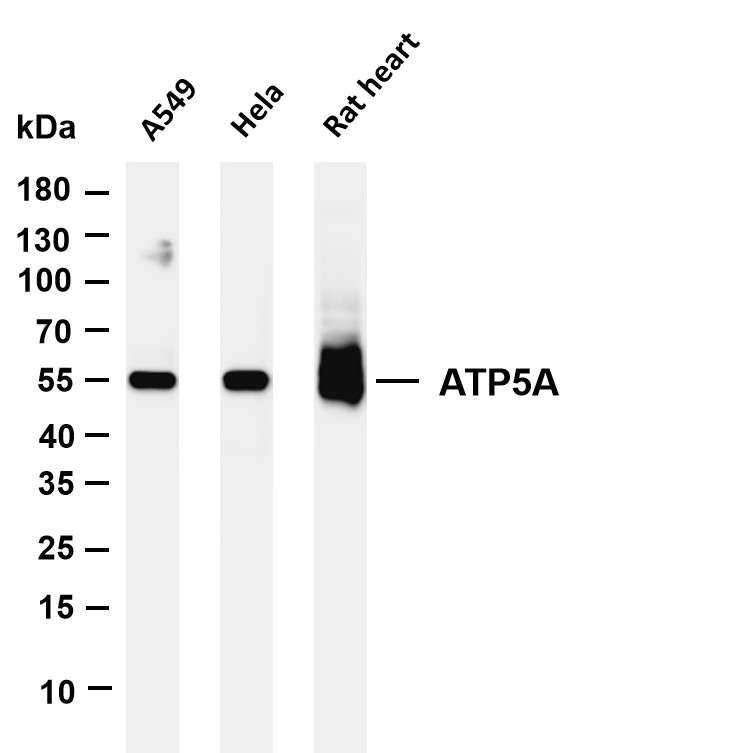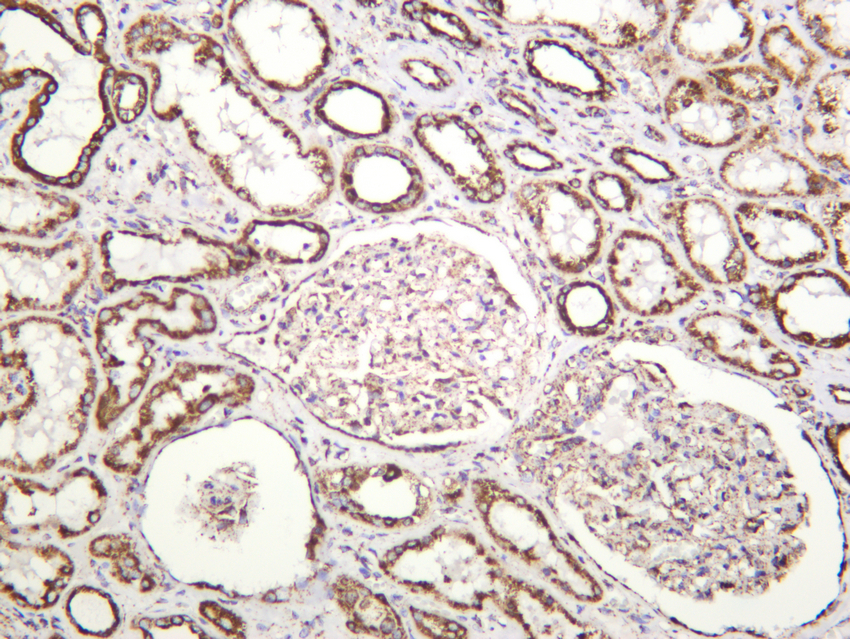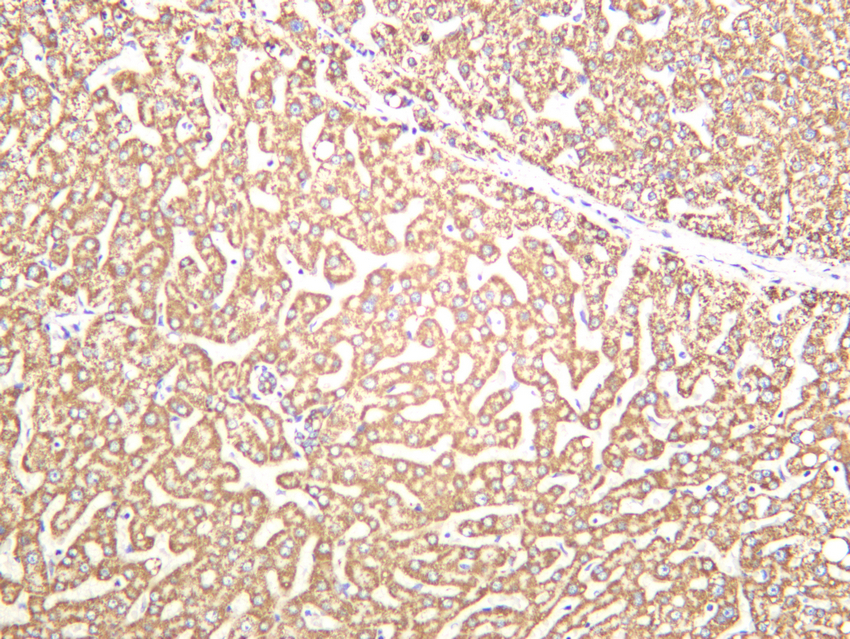ATP5A (PT0255R) PT® Rabbit mAb
- 货号:YM8161
- 应用:WB;IHC;IF;IP;ELISA
- 种属:Human; Mouse; Rat;
- 靶点:
- ATP5A
- 简介:
- >>Oxidative phosphorylation;>>Metabolic pathways;>>Thermogenesis;>>Alzheimer disease;>>Parkinson disease;>>Amyotrophic lateral sclerosis;>>Huntington disease;>>Prion disease;>>Pathways of neurodegeneration - multiple diseases;>>Chemical carcinogenesis - reactive oxygen species;>>Diabetic cardiomyopathy
- 基因名称:
- ATP5A1
- 蛋白名称:
- ATP synthase subunit alpha mitochondrial
- Human Gene Id:
- 498
- Human Swiss Prot No:
- P25705
- Mouse Gene Id:
- 11946
- Mouse Swiss Prot No:
- Q03265
- Rat Gene Id:
- 65262
- Rat Swiss Prot No:
- P15999
- 特异性:
- endogenous
- 组成:
- PBS, 50% glycerol, 0.05% Proclin 300, 0.05%BSA
- 来源:
- Monoclonal, rabbit, IgG, Kappa
- 稀释:
- IHC 1:200-1:1000;WB 1:2000-1:10000;IF 1:200-1:1000;ELISA 1:5000-1:20000;IP 1:50-1:200;
- 纯化工艺:
- Protein A
- 储存:
- -15°C to -25°C/1 year(Do not lower than -25°C)
- 其他名称:
- ATP5A1;ATP5A;ATP5AL2;ATPM;ATP synthase subunit alpha; mitochondrial
- 分子量:
- 60kD
- 实测条带:
- 55kD
- 背景:
- This gene encodes a subunit of mitochondrial ATP synthase. Mitochondrial ATP synthase catalyzes ATP synthesis, using an electrochemical gradient of protons across the inner membrane during oxidative phosphorylation. ATP synthase is composed of two linked multi-subunit complexes: the soluble catalytic core, F1, and the membrane-spanning component, Fo, comprising the proton channel. The catalytic portion of mitochondrial ATP synthase consists of 5 different subunits (alpha, beta, gamma, delta, and epsilon) assembled with a stoichiometry of 3 alpha, 3 beta, and a single representative of the other 3. The proton channel consists of three main subunits (a, b, c). This gene encodes the alpha subunit of the catalytic core. Alternatively spliced transcript variants encoding the different isoforms have been identified. Pseudogenes of thi
- 功能:
- function:Mitochondrial membrane ATP synthase (F(1)F(0) ATP synthase or Complex V) produces ATP from ADP in the presence of a proton gradient across the membrane which is generated by electron transport complexes of the respiratory chain. F-type ATPases consist of two structural domains, F(1) - containing the extramembraneous catalytic core, and F(0) - containing the membrane proton channel, linked together by a central stalk and a peripheral stalk. During catalysis, ATP synthesis in the catalytic domain of F(1) is coupled via a rotary mechanism of the central stalk subunits to proton translocation. Subunits alpha and beta form the catalytic core in F(1). Rotation of the central stalk against the surrounding alpha(3)beta(3) subunits leads to hydrolysis of ATP in three separate catalytic sites on the beta subunits. Subunit alpha does not bear the catalytic high-affinity ATP-binding sites.,
- 细胞定位:
- Mitochondrion
- 组织表达:
- Fetal lung, heart, liver, gut and kidney. Expressed at higher levels in the fetal brain, retina and spinal cord.
- June 19-2018
- WESTERN IMMUNOBLOTTING PROTOCOL
- June 19-2018
- IMMUNOHISTOCHEMISTRY-PARAFFIN PROTOCOL
- June 19-2018
- IMMUNOFLUORESCENCE PROTOCOL
- September 08-2020
- FLOW-CYTOMEYRT-PROTOCOL
- May 20-2022
- Cell-Based ELISA│解您多样本WB检测之困扰
- July 13-2018
- CELL-BASED-ELISA-PROTOCOL-FOR-ACETYL-PROTEIN
- July 13-2018
- CELL-BASED-ELISA-PROTOCOL-FOR-PHOSPHO-PROTEIN
- July 13-2018
- Antibody-FAQs
- 产品图片

- Various whole cell lysates were separated by 4-20% SDS-PAGE, and the membrane was blotted with anti-ATP5A (PT0255R) antibody. The HRP-conjugated Goat anti-Rabbit IgG(H + L) antibody was used to detect the antibody. Lane 1: A549 Lane 2: Hela Lane 3: Rat heart Predicted band size: 60kDa Observed band size: 55kDa

- Human kidney was stained with anti-ATP5A (PT0255R) rabbit antibody

- Human liver was stained with anti-ATP5A (PT0255R) rabbit antibody

- Rat kidney was stained with anti-ATP5A (PT0255R) rabbit antibody



